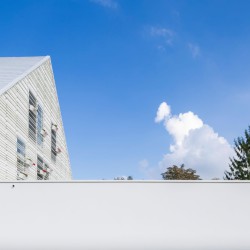dmvA . photos: © Sergio Pirrone . + archdaily
Liesje Reyskens is a young Belgian art photographer. She prefers working with young cute models, portrayed as dolls in a colourful, pink and barbie-like world.
_
The Flemish rural development is characterized by a ribbon development. Along the main roads, you will find a lot of detached and semi-detached houses. The brief of our client was to design a contemporary house with integrated workspace that could be used as exhibition space as well.
Keywords in her program of requirements were flexibility, light, privacy and the tight budget.
The biggest challenge was to give an architectural response to the adjacent house on the left side of the building plot.
dmvA started designing by searching for the ideal form that fitted in with the adjacent house. The new building consists of an almost completely closed ground floor and a rather small upper structure with a gabled roof.
dmvA designed a completely open living and workspace, structured and divided into different sections by three inner courtyards. The patio’s act as light-catchers and ‘ambiance generators’.
dmvA wanted to create an icon, a landmark, as a response to the often-ridiculous building regulations and the unadapted town planning regulations in Flanders. So they opted for white and smooth plasterwork as finishing material for all facades. To reinforce the monolith character of the new building, the gabled roof is finished by white tiles.
To reduce energy cost, dmvA opted for a green roof. The side facade of the archetype-like superstructure is finished as a double skin, consisting of horizontal white aluminium bars and hanging flower boxes. Pink flowers refer to the work of the photographer.























































